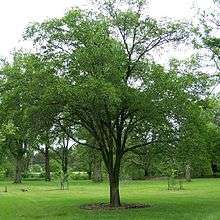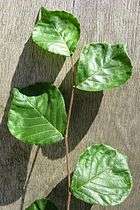Ulmus macrocarpa
| Ulmus macrocarpa | |
|---|---|
 | |
| Morton Arboretum accession 589-54*3 | |
| Scientific classification | |
| Kingdom: | Plantae |
| (unranked): | Angiosperms |
| (unranked): | Eudicots |
| (unranked): | Rosids |
| Order: | Rosales |
| Family: | Ulmaceae |
| Genus: | Ulmus |
| Species: | U. macrocarpa |
| Binomial name | |
| Ulmus macrocarpa Hance | |
| Synonyms | |
| |
Ulmus macrocarpa Hance, the large-fruited elm, is a deciduous tree or large shrub endemic to the Far East excluding Japan. It is notable for its tolerance of drought and extreme cold and is the predominant vegetation on the dunes of the Khorchin sandy lands in the Jilin province of north-eastern China, making a small tree at the base of the dunes, and a shrub at the top .
Description

By the age of ten years, the tree bears a close resemblance to the American elm U. americana, but will never approach the latter's size. The tree can reach a height of 17 m, with a slender trunk rarely exceeding 0.4 m d.b.h; the bark is longitudinally fissured, and dark grey in colour. The twigs often develop corky wings that may persist for several years. The leaves are usually obovate < 9 cm long by 5 cm broad (significantly smaller on juvenile trees) and chiefly characterized by their thick, leathery texture and obtusely doubly or simply toothed margins. The perfect, wind-pollinated apetalous flowers appear from March until May. As implied by its name, U. macrocarpa is distinguished by its large, orbicular, wafer-like samarae < 50 mm in diameter, which ripen in May and June.[1][2]
Pests and diseases
Possessed of a moderate resistance to Dutch elm disease and a low susceptibility to elm yellows, it has also proven very resistant to the elm leaf beetle Xanthogaleruca luteola in trials in Oklahoma and Italy.[3]
Cultivation
The species was introduced to the United States at the Arnold Arboretum, Massachusetts, in 1908, and to the UK at Aldenham House in Hertfordshire, almost certainly as part of the quincunx elm avenue leading to the front of the house,[4] by Vicary Gibbs (1853–1932) in the late 19th century.[5] What remained of the avenue after the advent of Dutch elm disease was cleared circa 1980 to make way for a cricket pitch.
The tree has been assessed at the Morton Arboretum, Illinois, for its landscape potential, and is now considered suitable for open areas such as parks and campuses.[6] Typically, U. macrocarpa is intolerant of poorly drained ground prone to waterlogging. U. macrocarpa has been found to be the most cold hardy of the Chinese elms. In artificial freezing tests at the Morton Arboretum [7] the LT50 (temp. at which 50% of tissues die) was - 36 °C.
Subspecies & varieties
Two varieties are recognized: var. glabra Nie & Huang and var. macrocarpa L.K.Fu
Hybrids, hybrid cultivars and cultivars
A natural hybrid of U. macrocarpa and U. davidiana var. japonica, named Ulmus × mesocarpa was discovered in South Korea in the 1980s. U. macrocarpa is believed to have been used in recent (post 2000) hybridization experiments at the Morton Arboretum [3] but results have yet (2008) to be published. There are no known cultivars of this taxon.
Accessions
- North America
- Arnold Arboretum. Acc. nos. 17911, 346–82 (no provenances for either), 377–40 collected in China.
- Denver Botanic Gardens, one specimen, no details available
- Holden Arboretum. Listed as U. macrocarpa var. dorsetti (unrecognized variety), acc. no. 97–26.
- Morton Arboretum. Acc. nos. 589–64, 179–84, 286–95, 589-54*3.
- U S National Arboretum , Washington, D.C., United States. Acc. nos. 70030, 76229, 76230, 76231, 76247, 68915. Also, listed as U. macrocarpa var. dorsettii: 68990, 76232, 64253.
- Europe
- Botanic Garden of the University of Copenhagen, no details available
- Brighton & Hove City Council, NCCPG Elm Collection.[8]
- Cambridge Botanic Garden , University of Cambridge, UK. No accession details available.
- Grange Farm Arboretum , Sutton St. James, Spalding, Lincs., UK. Acc. no. 831, as var. Dorsettii.
- Linnaean Gardens of Uppsala, Sweden. Acc. nos. 1976–1142, 1976–2032, 0000–1484.
- Royal Botanic Garden Edinburgh. Acc. no. 20022149 (grown from seed sold by Lawyer Nursery, USA).
- Strona Arboretum, University of Life Sciences, Warsaw, Poland. No details available.
- Wijdemeren Elm Arboretum, Frans Halslaan, Loosdrecht, Netherlands
Nurseries
- North America
- Europe
- A Touch of Green , Amstelveen, Netherlands.
- Arboretum Waasland , Nieuwkerken-Waas, Belgium.
- Noordplant Nursery , Glimmen, Netherlands.
References
- ↑ Fu, L. & Jin J. (eds). (1992). China Red Data Book. Rare and endangered plants. Vol. 1. Science Press, Beijing
- ↑ Fu, L., Xin, Y. & Whittemore, A. (2002). Ulmaceae, in Wu, Z. & Raven, P. (eds) Flora of China, Vol. 5 (Ulmaceae through Basellaceae). Science Press, Beijing, and Missouri Botanical Garden Press, St. Louis, USA.
- 1 2 Mittempergher, L. & Santini, A. (2004). The History of Elm Breeding. Invest. Agrar.: Sist Recur For. 2004 13 (1), 161–177.
- ↑ Audrey Le Lievre (1986). An Account of the Garden at Aldenham House and of Its Makers: Henry Hucks Gibbs, Vicary Gibbs and Edwin Beckett. Garden History, Vol. 14, No. 2. (Autumn, 1986), 173–193.
- ↑ Bean, W. J. (1981). Trees and shrubs hardy in Great Britain, 7th edition. Murray, London
- ↑ Ware, G. (1995). Little-known elms from China: landscape tree possibilities. Journal of Arboriculture, (Nov. 1995). International Society of Arboriculture, Champaign, Illinois, USA.
- ↑ Shirazi, A. M. & Ware, G. H. (2004). Evaluation of New Elms from China for Cold Hardiness in Northern Latitudes. International Symposium on Asian Plant Diversity & Systematics 2004, Sakura, Japan.
- ↑ "List of plants in the {elm} collection". Brighton & Hove City Council. Retrieved 23 September 2016.
Further reading
- Kwon, Y. M., J. H. Lee, and M. W. Lee. Phenolic compounds from barks of Ulmus macrocarpa and its antioxidative activities. Korean Journal of Pharmacognosy 33.4 (2002): 404–410.
- Oh, Kwang-Seok, et al. Antihypertensive, vasorelaxant, and antioxidant effect of root bark of Ulmus macrocarpa. Biological and Pharmaceutical Bulletin 31.11 (2008): 2090–2096.
- Kim, Hyun Jung, et al. Nitric oxide and Prostaglandin E₂Synthesis Inhibitory Activities of Flavonoids from the Barks of Ulmus macrocarpa. Natural Product Sciences 10 (2004).
- Ulmus macrocarpa _Large-fruited Elm.